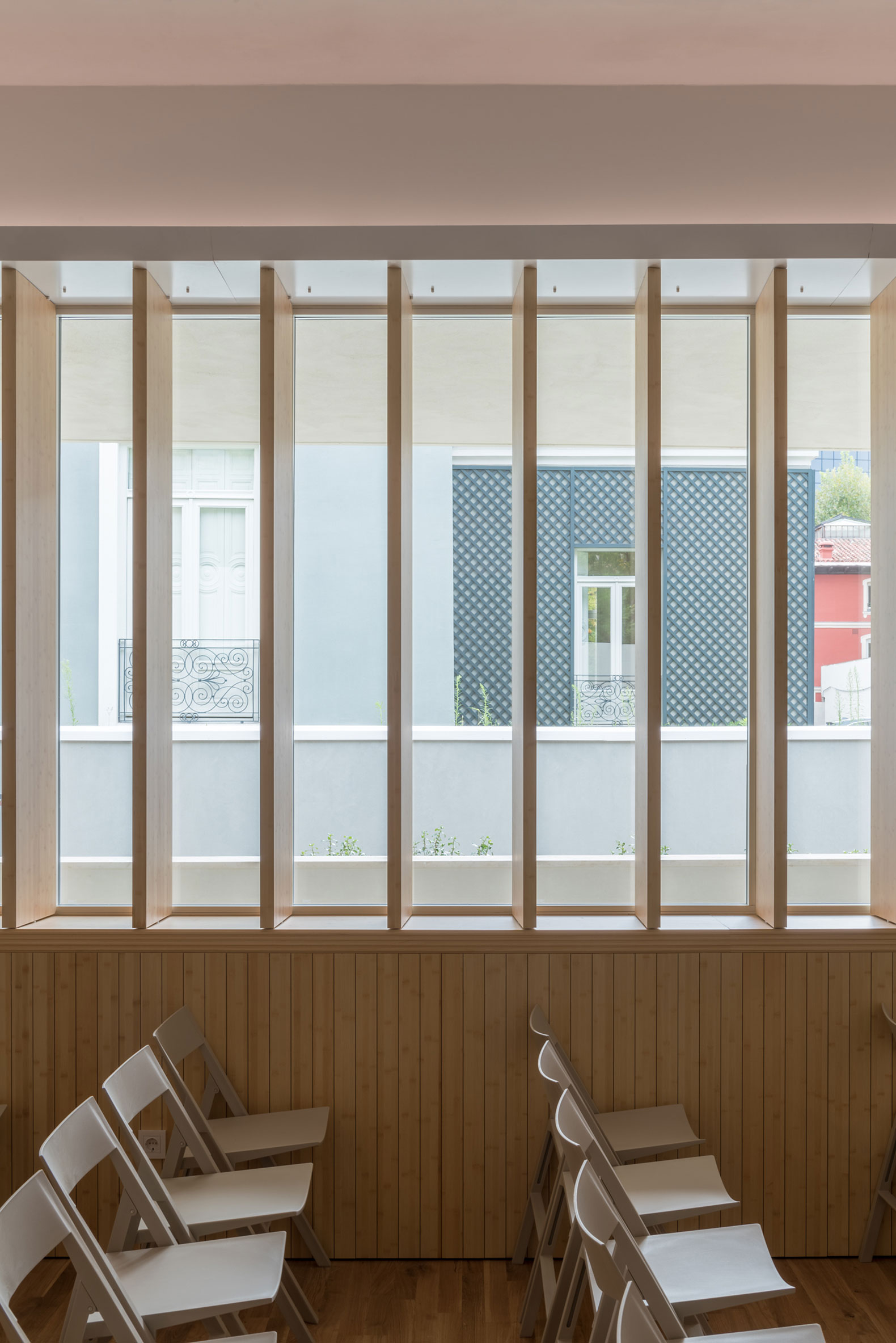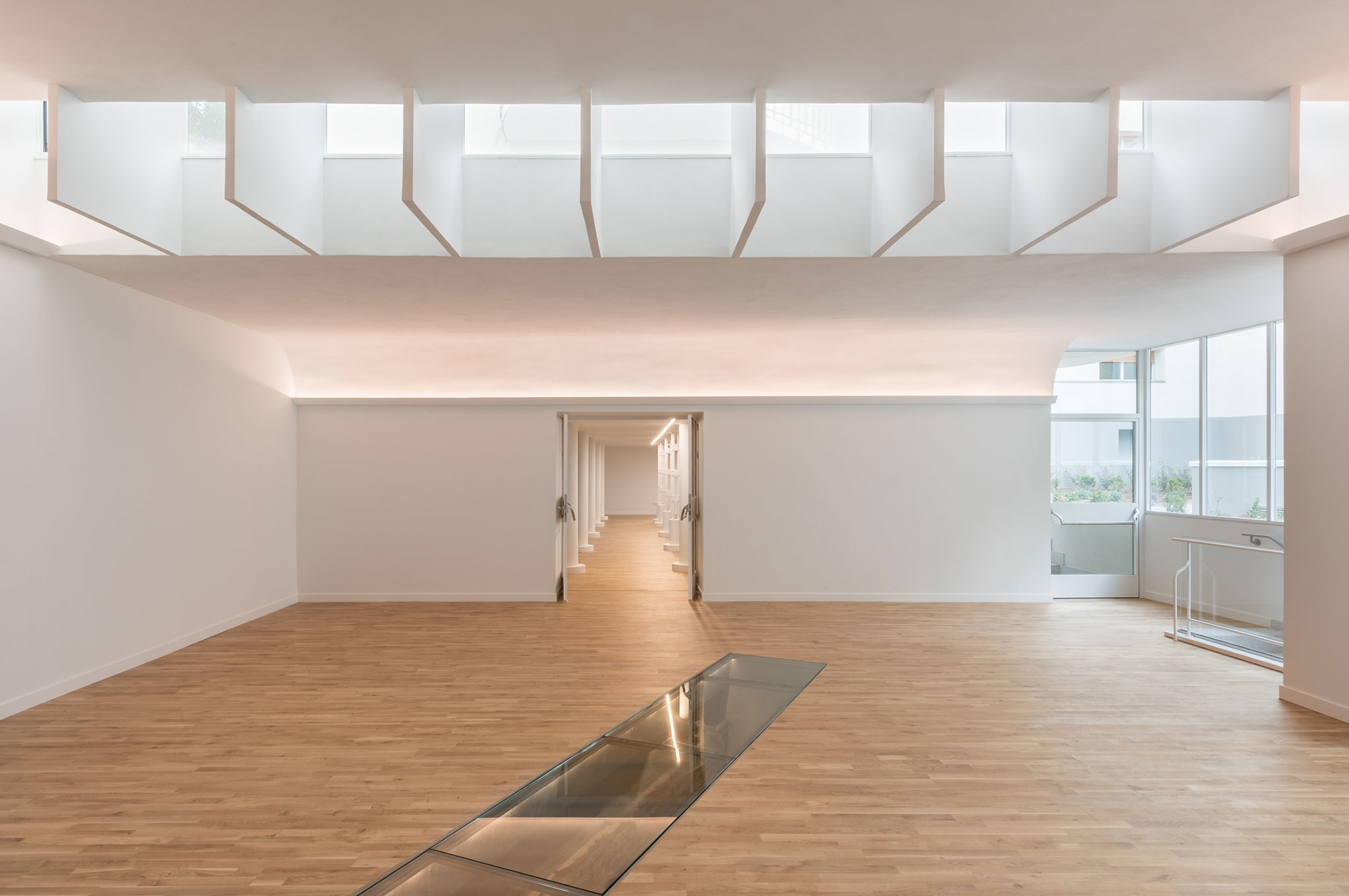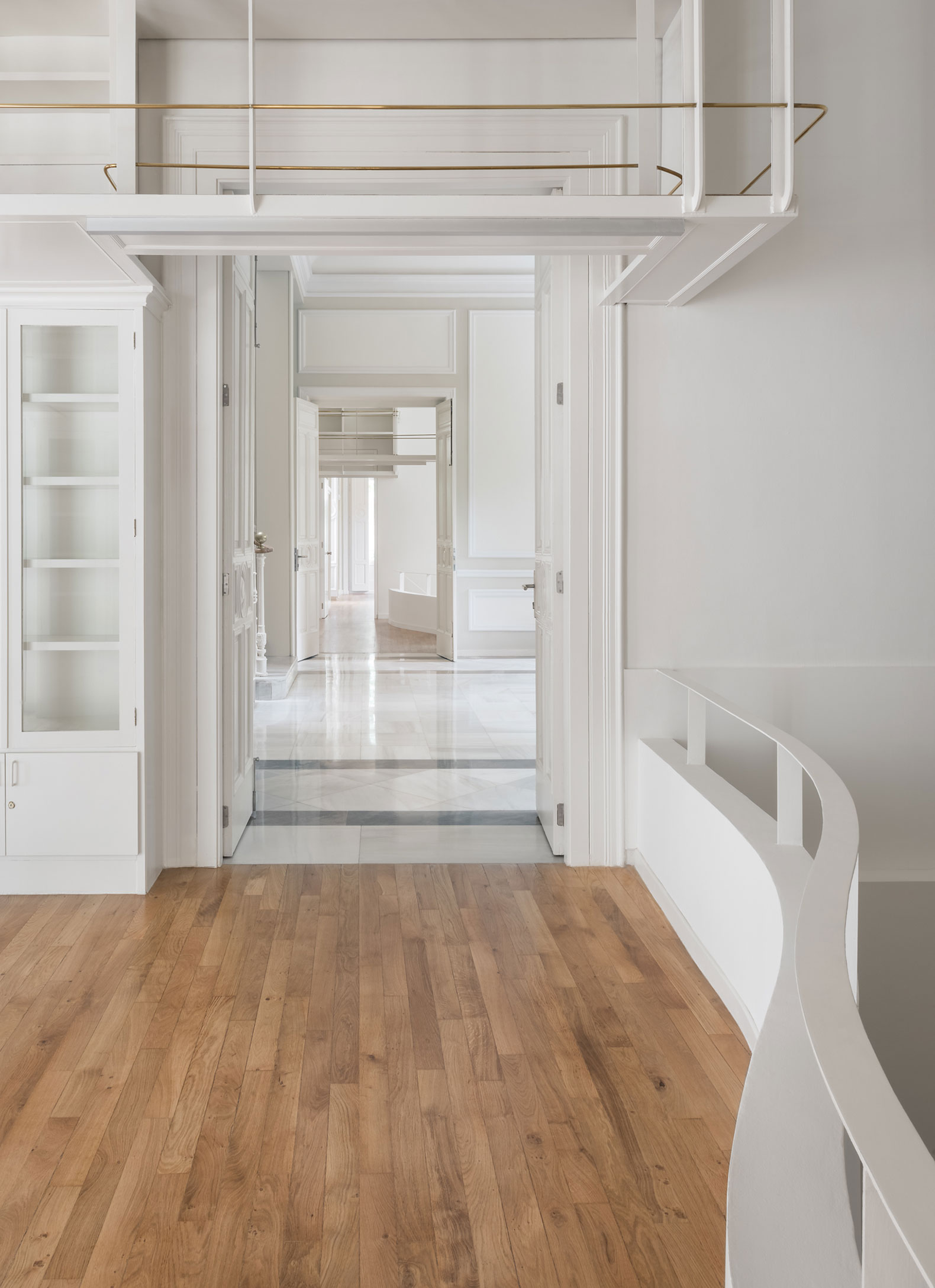The new project has been carried out to adapt to new functions, demanding more archive space, a new mixed-use room and three exhibition rooms, one temporary and another two permanent dedicated to Ortega y Marañón, forming the FOM Headquarters as a mini campus of three buildings on a garden.
After almost a decade of careful work and careful restoration work by Junquera Arquitectos, in which maximum care has been taken to maintain the hallmarks of the buildings, the result allows us to recognize the traces and typologies of the history of the complex, its envelopes and materials.
The masterly intervention is completed with an elegant volume that blends in with the Arniches building, for which the formal language of the Modern Movement has been used in its envelopes and materials. A discreet semi-buried piece, which from the outside does not protrude above the garden walls in such a way that it is not visually perceived.

José Ortega y Gasset Gregorio Marañón Foundation by Junquera Arquitectos. Photograph by Lucía Gorostegui.
 José Ortega y Gasset Gregorio Marañón Foundation by Junquera Arquitectos. Photograph by Lucía Gorostegui.
José Ortega y Gasset Gregorio Marañón Foundation by Junquera Arquitectos. Photograph by Lucía Gorostegui.
Project description by Junquera Arquitectos
Dialogue between three buildings and three times
Built in 1857 as a residential palace, in 1915 it became the Headquarters of the American Foundation of the Boston International Institute whose main mission was to promote women's access to university life. As a result of cooperation between institutions, the mansion was transferred to the Board for the Extension of Studies and Scientific Research, to house the Ladies' Residence directed by Maria de Maeztu.
Given the success of the demands in 1932, Carlos Arniches was entrusted with a second annex building focused on individual bedrooms. A building that became a benchmark for the architecture of the Spanish modern movement.
During the dictatorship, her condition of residence was maintained under the tutelage of the Women's Section of the Spanish Falange.
Already in democracy, the Spanish Government ceded it to the Ortega y Gasset Foundation and declared the complex an Asset of Cultural Interest (garden, buildings and archives).
It currently houses the Library and the legacy of the philosopher Ortega y Gasset and the doctor Gregorio Marañón, expanded during the last forty years becoming a reference archive
In 1984, the foundation entrusted Jeronimo Junquera and Estanislao Perez Pita with its rehabilitation and adaptation to new uses (educational and cultural facilities, offices and classrooms).

José Ortega y Gasset Gregorio Marañón Foundation by Junquera Arquitectos. Photograph by Lucía Gorostegui.
In 2014, the Foundation entrusted Junquera Arquitectos (deceased Estanislao Perez Pita) with a second Rehabilitation to adapt to new functions, demanding more space for archives, a new mixed-use room and three exhibition rooms, one temporary and two other permanent ones dedicated to Ortega. and Marañón, forming the Headquarters of the FOM as a mini campus of three buildings on a garden.
The rehabilitation criteria have been to maintain as much as possible the hallmarks of the buildings and the garden since their birth, in different degrees, depending on the uses that these buildings have received in their more than 150 years of history, residential palace , ladies' bedrooms, FOM headquarters, documentary archive, researchers' offices and now exhibition rooms and a multipurpose room.
Today, with the finished work, the traces of its history can be recognized, maintaining in the existing buildings references to their historical typologies, envelopes and materials...
The new volume merges with the Arniches Building using the language of the Modern Movement in its envelopes and materials. It is implanted semi-buried, without protruding from the coronation of the garden walls in such a way that it goes unnoticed from the outside.

José Ortega y Gasset Gregorio Marañón Foundation by Junquera Arquitectos. Photograph by Lucía Gorostegui.

José Ortega y Gasset Gregorio Marañón Foundation by Junquera Arquitectos. Photograph by Lucía Gorostegui.
The three typologies and their relationship
The residential palace of the 19th century
A "classic" typology structured by three naves, a central one that houses the access, the staircase and the services, generating a central axis that in the main façade is emphasized with the construction of a glass volume under which the entrance is implanted through a staircase that saves the height of the plinth on which the building is implanted.
It is in the incorporation of new uses that rehabilitation has acted with more freedom to generate new compartmentalizations of the two side naves without modifying the openings in the façade, which calls for creating half-window encounters designed with steel carpentry as glass eardrums. and wood.
All these typological and structural elements have been maintained since their origin, except for the compartmentalization of the exterior spaces that were adapted to their new uses. This is where the rehabilitation has acted with more freedom to generate new partitioning of the two side naves without modifying the openings in the façade, which calls for creating half-window encounters designed with steel carpentry as glass and wood eardrums.
The intervention is complemented by the creation of two libraries with a mezzanine and a communication with the semi-basement recovered for the archives through two separate voids.
In order to respond to documentary growth, the semi-basement is extended, generating a raised garden area, at the crown level of the original plinth.
The austerity of the materials is maintained, plastered facades with painted wood carpentry and the steel carpentry of the gazebo. Wooden floors and brick partitions finished in painted plaster

José Ortega y Gasset Gregorio Marañón Foundation by Junquera Arquitectos. Photograph by Lucía Gorostegui.
La Residencia de Señoritas, Arniches building
Located in the background of the "mansion", almost touching it, through a subtle embrace of the curved volume of the staircase.
It responds to the classic “hotel” typology, a corridor that threads the doors of the rooms and in the bank the common toilets are located, creating towards Gral. Martinez Campos a large window and overhanging terraces that generate the most iconic façade of the building. In the extension it has been a reference as a key element in the formalization of the new façade. The interior, small-scale spaces, except for the staircase, wide in its traces and beautiful in its design.
A building resolved with austere materials that have been maintained by rehabilitating it, a plaster façade, steel carpentry with wooden roller shutters and a Catalan-style flat roof.
Today its first floors are reserved for exhibition spaces of small formats, books, letters, documents and images of Ortega y Marañón. These small formats have made it possible to design a continuous sequence of exhibition subspaces while maintaining the reference to the spaces of the original rooms.
The rest of the floors, the original spaces, are adapted to researchers' offices.

José Ortega y Gasset Gregorio Marañón Foundation by Junquera Arquitectos. Photograph by Lucía Gorostegui.

José Ortega y Gasset Gregorio Marañón Foundation by Junquera Arquitectos. Photograph by Lucía Gorostegui.
The new building. New door of broadcasting and flexible use assembly room
The FOM has established itself as a reference institution in our country, cultural, educational, investigative and guarantor of a documentary collection in continuous growth that demands a public projection that disseminates it to society, a welcoming space, a new door and a multipurpose room, assembly hall, seminars…. All this had no place in the two existing buildings, which is why it was decided to incorporate a new building.
We understood from the beginning that a third piece with its own personality was too much to force the limited free space we had, so we opted to seek an ambiguous relationship with the Arniches building, using its architectural language and its materials so that in the future they would blend. A silent performance, whose ambiguity in the future will make it difficult to perceive whether or not it is part of Arniches's proposal.
We place it attached to the wall of Miguel Angel street, without exceeding its coronation, in continuity with the Arniches building, sinking it slightly to the level of the semi-basement in continuation with the temporary exhibition hall. The perception from the street remains unchanged.

José Ortega y Gasset Gregorio Marañón Foundation by Junquera Arquitectos. Photograph by Lucía Gorostegui.
The volume has a single façade that overlooks the garden through a continuous window protected by mobile wooden slats to adapt the light to the various activities. A large window covered by a cantilever similar to the balconies designed by Arniches, which protects and frames the access ramp to the reception hall from which you access the multipurpose room and the exhibition rooms.
The room is configured as a parallelepiped volume, acoustically ideal, to which is added a continuous box on one side under which the furniture is stored to quickly transform the space depending on the act.
The lobby is the hinge that connects the new room with the Arniches building.
Given that this building was born with the vocation of merging mimetically with the Residencia de Señoritas, it uses the same materials and finishes, plastered facades, steel carpentry, wood. Only the ventilated flat roof maintains the same typology, changing the Catalan tile for white ceramic panels.













































































